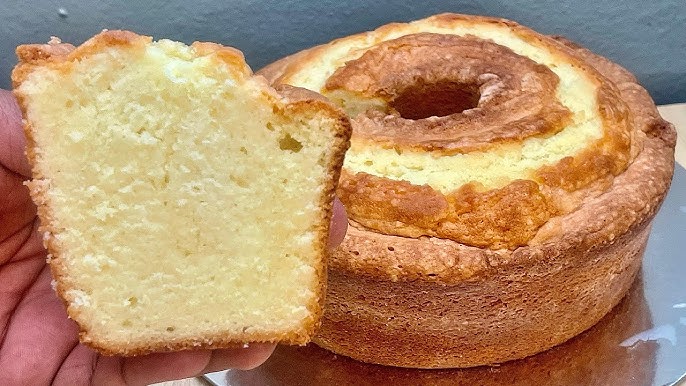Sour Cream Pound Cake Recipe: There’s something timeless and irresistible about a classic pound cake. It’s dense, buttery, and full of rich flavor—but add sour cream into the mix, and you’re elevating that goodness to a whole new level. A sour cream pound cake is not just a dessert; it’s a warm hug from the oven, rich in taste and perfect in texture.
What Makes Sour Cream Pound Cake Special?
You might be wondering, “Why sour cream?” Well, here’s the magic—it adds a subtle tanginess that balances the sweetness while also keeping the cake incredibly moist. Unlike other pound cakes that might dry out after a day or two, a sour cream pound cake stays tender and fresh for days. Plus, it has a rich crumb and a slightly crisp crust that make it just right for any occasion.
Whether you’re baking for a family gathering, holiday feast, or simply to indulge in a slice of joy with your morning coffee, this cake is a winner every single time.
The Origin and Popularity of Pound Cakes
Pound cake got its name from its original recipe, which used a pound each of butter, sugar, eggs, and flour. Over time, the recipe evolved to suit modern tastes and baking methods. Sour cream versions started becoming popular in the mid-20th century and have stayed in demand ever since. Why? Because they bring the perfect balance of flavor, texture, and longevity.
Today, you’ll find sour cream pound cakes served at everything from weddings to Sunday dinners across the Southern U.S. and beyond. It’s not just a dessert—it’s tradition.
Ingredients for Sour Cream Pound Cake
Before you preheat that oven, let’s break down what you’ll need to bring this delicious creation to life.
Must-Have Ingredients
Here’s a basic ingredient list for a classic sour cream pound cake:
- 1 cup (2 sticks) unsalted butter, softened
- 3 cups granulated sugar
- 6 large eggs
- 3 cups all-purpose flour
- 1/2 teaspoon baking soda
- 1/4 teaspoon salt
- 1 cup sour cream (full-fat works best)
- 1 teaspoon vanilla extract
Each ingredient plays a key role. The butter brings in the richness. Sugar not only sweetens but helps with texture and color. Eggs bind everything and add structure. Flour is your base. Baking soda ensures the cake rises just enough, and sour cream adds that signature moistness and tang.
Optional Add-ins and Flavor Variations
If you want to give your cake a twist, here are a few ideas:
- Lemon or orange zest for a citrusy note
- Almond extract for a nutty depth
- Chocolate chips for added indulgence
- Crushed nuts like pecans or walnuts for crunch
- A glaze or icing drizzle if you’re feeling fancy
This cake is versatile, so feel free to get creative.
Tools and Equipment You’ll Need
You don’t need a fancy kitchen to whip up this beauty, but a few reliable tools can make all the difference.
Baking Essentials
- A hand mixer or stand mixer – for beating butter and sugar properly
- A 10-inch bundt pan or tube pan – the traditional shape for pound cake
- Mixing bowls – preferably in different sizes
- Rubber spatula – for scraping every last bit of batter
- Measuring cups and spoons – accuracy matters!
Proper tools ensure even mixing, thorough baking, and the kind of presentation that wows your guests.
Substitutes If You’re Missing Tools
No bundt pan? No problem. You can use two loaf pans instead—just be sure to watch the baking time, as smaller pans may cook faster. Don’t have an electric mixer? A strong arm and a whisk can do the job, but it’ll take more effort and time to get the same fluffy texture.
Step-by-Step Instructions for Making Sour Cream Pound Cake
Now, let’s get to the fun part—baking! Follow these easy steps, and you’ll have a perfect pound cake ready in no time.
Step 1 – Preparing Your Ingredients
Start by gathering all your ingredients. Make sure your butter, eggs, and sour cream are at room temperature—this ensures they blend smoothly and give you that melt-in-your-mouth texture.
Preheat your oven to 325°F (163°C) and grease your bundt or tube pan with butter and a light dusting of flour, or use non-stick spray with flour.
Step 2 – Mixing the Batter
Cream the butter and sugar together until the mixture is light and fluffy—this usually takes about 5 minutes with an electric mixer on medium speed. This step is key for incorporating air into the batter, which helps the cake rise properly.
Next, beat in the eggs one at a time, making sure each is fully mixed before adding the next. This gradual approach keeps the batter from curdling.
In a separate bowl, sift together the flour, baking soda, and salt. Add this dry mixture to the butter mixture in thirds, alternating with the sour cream. Begin and end with flour. Finally, stir in the vanilla extract.
You should have a thick, silky batter ready to go!
Step 3 – Baking the Cake
Pour the batter into your prepared pan and smooth the top with a spatula. Tap the pan gently on the counter to remove air bubbles.
Bake in the center of the oven for 1 hour and 20 minutes to 1 hour and 30 minutes, or until a toothpick inserted into the center comes out clean. Don’t open the oven door too soon—this can cause your cake to collapse!
Step 4 – Cooling and Serving Tips
Once your cake is done baking, let it cool in the pan for 15-20 minutes. Then, carefully invert it onto a wire rack to cool completely. Resist the temptation to slice into it right away—pound cake is best after it’s had time to rest and set.
Serve it plain, dusted with powdered sugar, or topped with whipped cream and berries. No matter how you enjoy it, this cake is pure comfort in every bite.
Pro Tips for Perfect Pound Cake Every Time
Let’s face it—baking isn’t just about mixing stuff and tossing it into the oven. It’s part art, part science. And when it comes to pound cakes, especially sour cream pound cake, a few extra tips can make the difference between “meh” and “magnificent.”
Avoiding Common Baking Mistakes
Even seasoned bakers can trip up. Here are the top mistakes and how to dodge them:
- Cold ingredients: Always start with room-temperature butter, eggs, and sour cream. Cold butter won’t cream properly, and cold eggs can cause the batter to curdle.
- Overmixing: Be gentle once the flour goes in. Overmixing develops gluten, making the cake dense or rubbery instead of soft and velvety.
- Incorrect measuring: Use the scoop-and-level method for flour and always use proper measuring tools. Too much flour dries the cake; too little and it won’t set.
- Underbaking: A pound cake is dense and takes time to cook through. Don’t rush it. If the top browns too quickly, tent it with foil after the first 45 minutes.
- Opening the oven early: It’s tempting to peek, but every time you open that door, you drop the oven temperature. Wait until at least the 1-hour mark before checking.
Small adjustments in how you measure, mix, and monitor can elevate your cake from just good to unforgettable.
How to Store and Freeze Your Cake
Pound cake isn’t just delicious—it’s also one of the most storage-friendly desserts around.
For short-term storage:
- Wrap the cooled cake tightly in plastic wrap or aluminum foil.
- Store it at room temperature for up to 5 days. Keep it in a cool, dry place.
For long-term storage:
- Slice it and wrap individual pieces in plastic wrap, then place them in a zip-top freezer bag.
- Freeze for up to 3 months. To enjoy, thaw overnight at room temperature or microwave for 30 seconds.
And here’s a secret: pound cake tastes even better the next day as the flavors meld. So don’t be afraid to make it ahead!
FAQs about Sour Cream Pound Cake Recipe
1. Can I use Greek yogurt instead of sour cream?
Yes, Greek yogurt is a great substitute. It offers a similar tang and texture, though it’s slightly lighter than sour cream.
2. Why did my pound cake crack on top?
That’s normal! Pound cakes often crack because the batter is so dense—it rises and splits as it bakes. Think of it as a natural signature.
3. Can I make this cake gluten-free?
Absolutely. Substitute all-purpose flour with a 1:1 gluten-free baking blend. The texture might change slightly, but it’ll still be delicious.
4. What’s the best way to add lemon flavor to this cake?
Add 1–2 tablespoons of fresh lemon zest and a teaspoon of lemon extract or juice to the batter. You can also drizzle with a lemon glaze after baking.
5. How do I keep my cake from sticking to the pan?
Grease the pan thoroughly with butter or shortening and dust it lightly with flour. A baking spray with flour included is also effective.
Conclusion
Sour cream pound cake is the kind of dessert that never goes out of style. It’s simple, elegant, and packed with comfort and flavor. Whether you’re serving it at a party or sneaking a slice with your morning coffee, this recipe delivers every time. With just a few pantry staples and a little patience, you’ll have a moist, rich, golden-brown masterpiece that steals the spotlight.
So, grab your apron, follow these steps, and get ready to wow your taste buds (and probably your neighbors too). After all, there’s nothing quite like the magic of homemade cake.



